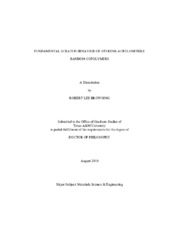| dc.contributor.advisor | Su, Hung-Jue | |
| dc.creator | Browning, Robert Lee | |
| dc.date.accessioned | 2011-10-21T22:03:23Z | |
| dc.date.accessioned | 2011-10-22T07:09:05Z | |
| dc.date.available | 2011-10-21T22:03:23Z | |
| dc.date.available | 2011-10-22T07:09:05Z | |
| dc.date.created | 2010-08 | |
| dc.date.issued | 2011-10-21 | |
| dc.date.submitted | August 2010 | |
| dc.identifier.uri | https://hdl.handle.net/1969.1/ETD-TAMU-2010-08-8473 | |
| dc.description.abstract | The present study employs a standardized progressive load scratch test (ASTM D7027/ISO 19252) to investigate the fundamental physical and mechanistic origins of scratch deformation in styrene-acrylonitrile (SAN) random copolymers. Previous findings from numerical simulation using finite element methods are used to establish correlation between mechanical properties and key scratch deformation mechanisms of the SAN model systems. For SAN, the acrylonitrile (AN) content and molecular weight (MW) can be changed to alter mechanical properties such as tensile strength and ductility.
The key scratch deformation mechanisms are identified as: scratch groove formation, scratch visibility, periodic micro-cracking and plowing. Groove formation has been correlated to the secant modulus at the compressive yield point while micro-cracking and plowing are related to the tensile strength of the material. The fundamentals and physical origins of scratch visibility are discussed. It is explained how unbiased evaluation is accomplished by means of an automatic digital image analysis software package (ASV®). Frictional behavior and the effects of scratch speed and moisture absorption are also addressed.
Increasing the AN content and/or the MW of the SAN random copolymers generally enhances the scratch resistance of the material with regard to the onset of the key deformation mechanisms. Increasing the scratch speed increases the brittleness of the material, resulting in failure at lower applied loads. Moisture absorption increases with AN content and imparts a degree of plasticization as the moisture diffuses into the sub-surface. This plasticization initially results in a degradation of scratch resistance with respect to the key deformation mechanisms, but then, after saturation, the moisture on the surface provides lubrication and improves the scratch resistance. It is important to note that polymers are fundamentally different in nature, but the findings of this study serve as an important stepping stone down the path to a deeper understanding of polymer scratch behavior. | en |
| dc.format.mimetype | application/pdf | |
| dc.language.iso | en_US | |
| dc.subject | Scratch behavior | en |
| dc.subject | polymers | en |
| dc.subject | structure-property relationship | en |
| dc.subject | styrene-acrylonitrile | en |
| dc.subject | mechanical properties | en |
| dc.subject | moisture absorption | en |
| dc.title | Fundamental Scratch Behavior of Styrene-Acrylonitrile Random Copolymers | en |
| dc.type | Thesis | en |
| thesis.degree.department | Mechanical Engineering | en |
| thesis.degree.discipline | Materials Science and Engineering | en |
| thesis.degree.grantor | Texas A&M University | en |
| thesis.degree.name | Doctor of Philosophy | en |
| thesis.degree.level | Doctoral | en |
| dc.contributor.committeeMember | Cheng, Zhengdong | |
| dc.contributor.committeeMember | Holzenburg, Andreas | |
| dc.contributor.committeeMember | Suh, Steve | |
| dc.type.genre | thesis | en |
| dc.type.material | text | en |


